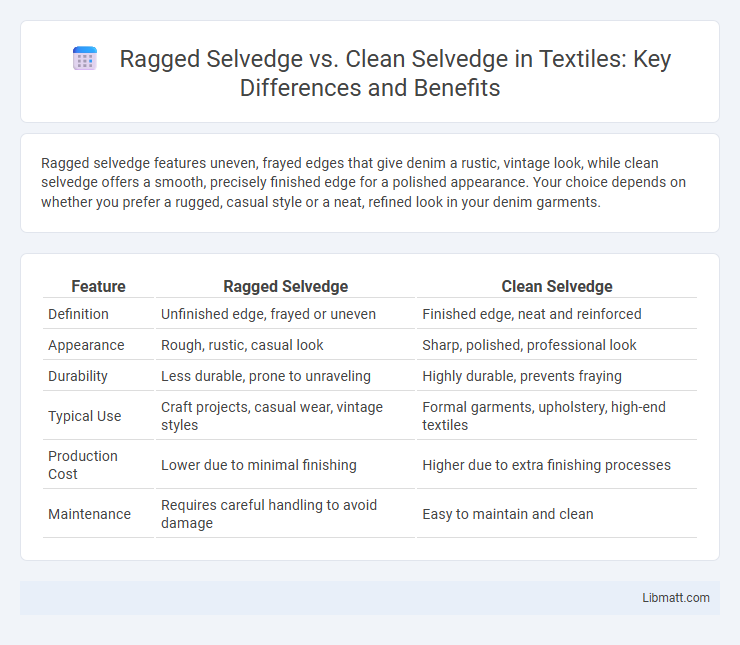Ragged selvedge features uneven, frayed edges that give denim a rustic, vintage look, while clean selvedge offers a smooth, precisely finished edge for a polished appearance. Your choice depends on whether you prefer a rugged, casual style or a neat, refined look in your denim garments.
Table of Comparison
| Feature | Ragged Selvedge | Clean Selvedge |
|---|---|---|
| Definition | Unfinished edge, frayed or uneven | Finished edge, neat and reinforced |
| Appearance | Rough, rustic, casual look | Sharp, polished, professional look |
| Durability | Less durable, prone to unraveling | Highly durable, prevents fraying |
| Typical Use | Craft projects, casual wear, vintage styles | Formal garments, upholstery, high-end textiles |
| Production Cost | Lower due to minimal finishing | Higher due to extra finishing processes |
| Maintenance | Requires careful handling to avoid damage | Easy to maintain and clean |
Introduction to Selvedge Denim
Selvedge denim features a tightly woven edge that prevents unraveling, produced on traditional shuttle looms for enhanced durability and distinct craftsmanship. Ragged selvedge refers to the uneven, frayed edge seen when the fabric is cut directly from the loom without finishing, often favored by denim enthusiasts for its authentic, vintage appeal. Clean selvedge, in contrast, displays a smooth, finished edge achieved through additional processing, offering a polished look that suits contemporary denim styles.
What is Ragged Selvedge?
Ragged selvedge refers to the unfinished, frayed edge of denim fabric that lacks a clean, tightly woven border, often found on lower-quality or vintage denim. This edge can fade or unravel more quickly compared to clean selvedge, which has a distinct, reinforced band running along the fabric edge to prevent fraying. Understanding the difference helps you identify the durability and authenticity of your denim garments.
What is Clean Selvedge?
Clean selvedge refers to the neatly finished edges of denim fabric woven on traditional shuttle looms, preventing fraying and unraveling. This edge is characterized by its tight, uniform thread structure and often features distinct colored lines, indicating authenticity and craftsmanship in premium denim. Clean selvedge enhances durability and aesthetic appeal compared to ragged selvedge, which has uneven, frayed edges.
Key Differences: Ragged vs Clean Selvedge
Ragged selvedge features an uneven, frayed edge commonly found on vintage or lower-quality denim, while clean selvedge boasts a tightly woven, clean finish with a distinct colored line that prevents unraveling. The key differences lie in durability and aesthetic appeal, as clean selvedge offers a refined look and greater longevity compared to the rugged, worn-in nature of ragged selvedge. Choosing your denim with clean selvedge ensures a polished appearance and enhanced fabric integrity.
Manufacturing Techniques for Selvedge Edges
Ragged selvedge edges are produced through traditional shuttle looms that create a naturally frayed and uneven finish due to the weft threads running continuously to the fabric's edge. Clean selvedge edges result from modern manufacturing techniques using projectile or rapier looms, which cut and seal the fabric edge precisely to prevent fraying. These contrasting techniques impact the durability and aesthetic quality of the selvedge, influencing fabric choice for denim and high-end textiles.
Visual Appeal: Aesthetic Comparison
Ragged selvedge features a rustic, uneven edge that adds a vintage, handcrafted look to denim, appealing to those who appreciate raw, authentic detailing. Clean selvedge offers a sharp, smooth finish that enhances the garment's polished and refined appearance, making it ideal for a sleek, modern style. Your choice depends on whether you prefer the rugged charm of ragged selvedge or the sophisticated elegance of clean selvedge to complement your denim aesthetic.
Durability and Wear: Which Lasts Longer?
Ragged selvedge denim typically features a raw, unfinished edge that can fray over time, making it less durable compared to clean selvedge denim, which has tightly woven edges that resist unraveling. Clean selvedge denim's tightly bound fibers provide enhanced structural integrity, resulting in longer-lasting wear and better resistance to daily abrasion. For durability and longevity, clean selvedge denim consistently outperforms ragged selvedge by maintaining its shape and minimizing fraying throughout extended use.
Style Considerations for Denim Enthusiasts
Ragged selvedge, characterized by its uneven edge and vintage appeal, offers denim enthusiasts a rugged, authentic look often favored in raw or heritage denim styles. Clean selvedge features a crisp, uniform edge that complements minimalistic and modern denim designs, emphasizing precision and craftsmanship. Choosing between ragged and clean selvedge hinges on personal style preferences, with ragged selvedge aligning with a worn-in aesthetic and clean selvedge enhancing a polished, refined appearance.
Choosing the Right Selvedge for Your Jeans
Selecting the right selvedge for your jeans depends on your style preference and durability needs. Ragged selvedge offers a rugged, vintage look with frayed edges that develop unique wear patterns, while clean selvedge provides a polished, straight edge known for higher durability and resistance to fraying. Considering factors like intended use, maintenance, and aesthetic appeal can guide you to choose between the authentic, worn-in character of ragged selvedge or the sharp, refined finish of clean selvedge jeans.
Conclusion: Which Selvedge Suits You?
Ragged selvedge offers a vintage, rugged look with raw edges that appeal to denim enthusiasts seeking authenticity and character. Clean selvedge provides a polished, refined finish ideal for those who prefer a crisp, professional appearance in their denim. Selecting between ragged and clean selvedge depends on personal style preferences and the desired balance between casual wear and sophisticated aesthetics.
Ragged Selvedge vs Clean Selvedge Infographic

 libmatt.com
libmatt.com